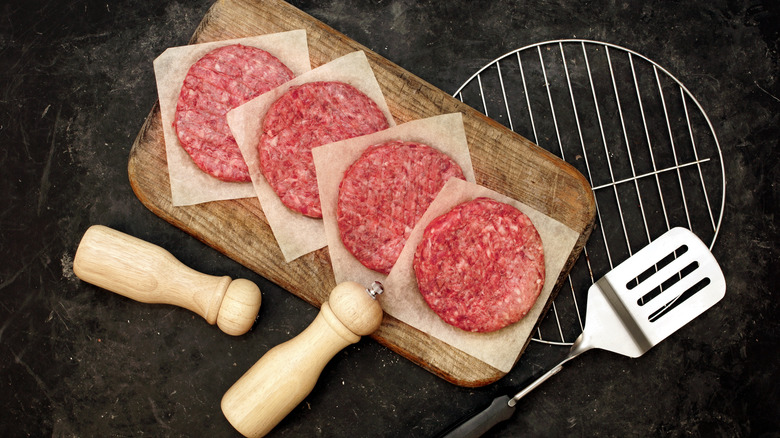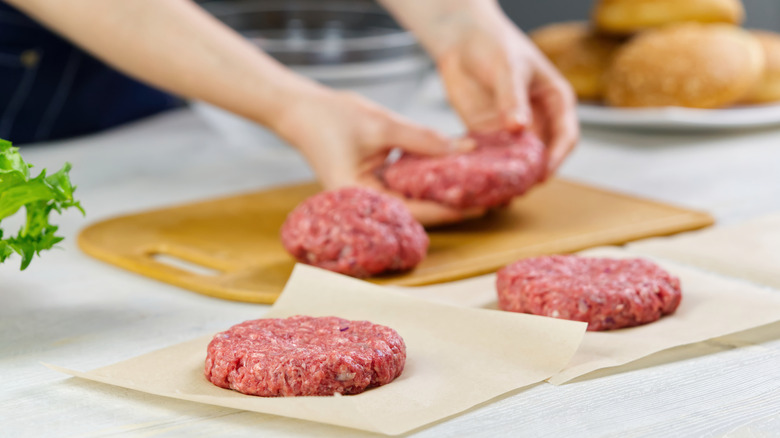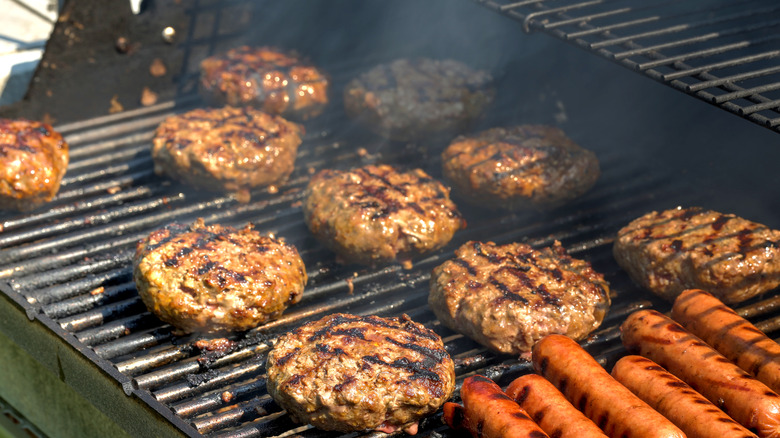The Tip You Need To Form The Best Burger Patties
What makes the best burger – is it the meat-to-bun ratio, the special sauce, or the meticulous assembly of toppings? A burger can be as simple as a patty on a bun, ordered from a drive-thru window, or it can be an ornate, multi-patty, cheese-covered, topping vehicle on artisan rolls. Because burger-meisters have pushed the sandwich to every culinary boundary, it's hard to concretely define the perfect hamburger. But if there's one consensus in the burger community — it's that a great burger starts with a great patty.
When crafting burger patties, it's important to consider the fat to lean meat ratio as leaner meats have a tendency to contract while cooking, resulting in a grainy patty that's tough and dry. Though some chefs like to experiment with various cuts of meat and fat ratios, most experts recommend using ground beef with a fat content of about 18% to 20%.
Moreover, when it comes to seasoning your ground beef, according to several chefs interviewed by Eater, less is more. Just a little bit of salt and pepper is necessary, as over-seasoning has the ability to undermine the elegant simplicity of a purist burger patty. When forming burgers by hand, patty shaping is another crucial step for retaining flavor, moisture, and tenderness. This simple trick can help keep them from turning into dry, bulbous meat pucks.
Avoid the pitfalls of patty crafting
Though everyone has their preference, the majority of burger aficionados prefer a flatter, crispy-edged patty for maximized bun coverage. If while cooking your patties start to bulge in the middle, be sure to avoid smooshing it into shape, because doing so renders out all the patty's moisture and flavor.
Patty shaping needs to happen before the meat touches heat, either by flattening the raw patty smash-style or by hand shaping it into three-quarter-inch thick discs with a center dimple to allow for even cooking (via Insider). But sculpting the perfect patty shape can result in overhandling, causing the meat to toughen the same way gluten does in bread dough.
The best way to avoid overhandling when working with fattier ground meats is to use wet hands to form the patties, according to the folks at Stubb's. Splashing a little water on your hands while shaping causes the meat (specifically the fat) to stick less to your hands and more to itself. Not only does it ease the shaping process to avoid overhandling, but also helps the patties come together faster and retain more fat in the meat.
Things to consider
Cooking on a grill, either gas or charcoal, can be a blessing or a curse. On one hand, cooking over an open flame adds a dimension of flavor, but it also risks drying out or over-charing the patty. In general, it's easier to cook thicker patties on the grill because there's less risk of the patty breaking apart and falling through the grate.
When it comes to the cold versus room-temperature patty debate, there're some contrasting approaches. Today recommends letting your meat come to room temperature before throwing it on the grill, while many other chefs advise keeping your patties cold until ready to grill. Both approaches have their merits, room-temperature patties help to ensure an even cook, but cold patties retain their shape and flavor better.
If cooking on a barbeque, it's better to use thicker cold patties so they are less likely to fall through the grate and the ambient heat in the grill helps to cook more evenly. Conversely, a flattop stove or pan is better suited to cook thinner room-temperature patties. With these essential tricks and tips for optimizing your patties, the burger is transformed into a culinary canvas used to explore a multitude of themes and flavors.


